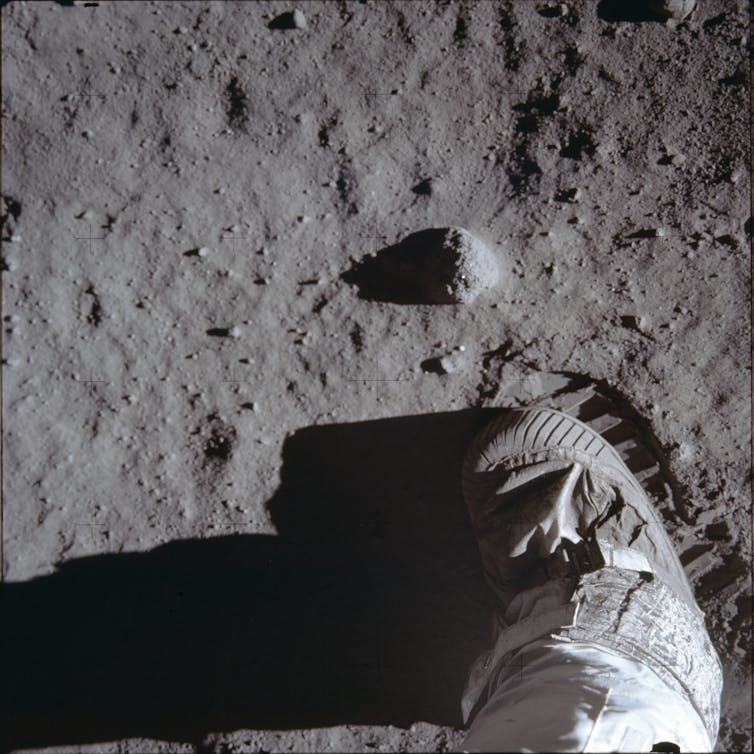The lunar south pole’s terrain is rugged, and it may well succeed in excessive temperatures. Credit score: Michael Karrer/Flickr, CC BY-NC
The U.S.’s go back to the Moon with NASA’s Artemis program might not be a trifling walk within the park. As an alternative it’s going to be a deadly adventure to a lunar location representing one of the crucial excessive environments within the sun machine.
For the Artemis program astronauts, strolling at the Moon would require new techniques of considering, the newest generation, and leading edge approaches to make stronger boot and spacesuit design.
The Apollo program’s trips to the Moon 50 years in the past had been all to the milder, equatorial areas of the lunar floor, the place the best temperatures reached -9 levels Fahrenheit (-23 levels Celsius).
By contrast, the Artemis missions are designed to take astronauts to the Moon’s excessive polar areas, the place temperatures can succeed in -369 levels Fahrenheit (-223 levels Celsius). Apollo-era apparatus designed for momentary remains in a average zone might not be sufficient for prolonged remains on this new, extra adversarial area.
On the College of North Dakota we center of attention on biomechanics, the find out about of human motion. Our analysis explores the results of utmost environments on human motion patterns and gait, and our lab conducts analysis that we are hoping will sooner or later assist astronauts discover the Moon whilst protective their frame.
New boots for the Moon
 The Apollo program represents the ultimate time people stepped onto the lunar floor. Edwin ‘Buzz’ Aldrin/NASA by way of AP
The Apollo program represents the ultimate time people stepped onto the lunar floor. Edwin ‘Buzz’ Aldrin/NASA by way of AP
Of all of the apparatus astronauts want to discover the Moon, one of the crucial essential items is the boots they’ll use for extravehicular process – once they step outdoor their spacecraft and soar around the lunar panorama. Those boots have to carry as much as the tough environmental stipulations distinctive to the lunar south pole.
Because the lunar poles are a lot less warm than different lunar areas, the boots will want to retain warmth successfully. The present iteration of the lunar boot makes use of a inflexible thermal plate, which is usually built-in into the only real of the boot. The plate is forged and does now not bend or flex. Those plates weren’t used throughout the sooner Apollo missions.
Whilst it’s important to stay astronauts’ toes heat, this addition to the boot prevents the shoes from flexing. The stiff sole restricts the foot’s herbal motion, particularly the joint on the giant toe, referred to as the the metatarsophalangeal, or MTP, joint. The MTP joint bends and flexes to facilitate customary strolling and working gait patterns.
The windlass mechanism
As you stroll, the MTP joint permits your giant toe to increase ahead. Extension of the massive toe triggers a mechanism within the foot that converts the versatile touchdown foot to a ridged pushing foot while you’re about to push ahead to step. This mechanism permits the foot to develop into inflexible and reinforce your frame weight thru your doorstep. Kinesiologists name this mechanism the windlass mechanism.
The windlass mechanism is helping propel your foot ahead whilst strolling.
The windlass mechanism isn’t smartly studied – specifically beneath lunar gravity. If this mechanism is necessary for strolling round at the Moon, it can be a downside that the boots stay an astronaut’s toes from bending.
There are 1,000,000 little main points that experience to head proper for a Moon project to be triumphant – how a lot flex is within the sole of the boots explorers use is only one that would in the long run affect their well being at the Moon.
Whilst an astronaut must be superb over the quick time period – days or even weeks – as soon as astronauts are staying at the Moon for months, they may increase a foot damage that may have an effect on different portions of the frame.
Kinesiologists like to inspect the human frame as a kinetic chain. That is to mention, when you harm a part of your decrease frame, your higher frame takes at the load of a lot of its purposes. A topic that starts within the foot might have an effect on the way in which an individual walks and stands, inflicting additional damage up the kinetic chain, thru compensatory mechanisms.
So, the kinetic chain describes how an damage within the decrease frame may just motive persistent damage in different different joints additional up the frame.
As NASA works on sending astronauts again to the Moon, researchers will want to be told extra about lunar gait to know how the foot reacts whilst shifting round beneath lunar gravity. What they be told will assist designers as they proceed to absolute best spacesuit designs.
![]()
Jesse Rhoades is Affiliate Professor of Schooling, Heath & Conduct on the College of North Dakota. Rebecca Rhoades is a Researcher in Schooling, Well being & Conduct on the College of North Dakota. Jesse Rhoades receives investment from NASA. Rebecca Rhoades does now not paintings for, seek the advice of, personal stocks in or obtain investment from any corporate or group that will take pleasure in this text, and has disclosed no related affiliations past their educational appointment.
This text is republished from The Dialog beneath a Ingenious Commons license. Learn the unique article.

